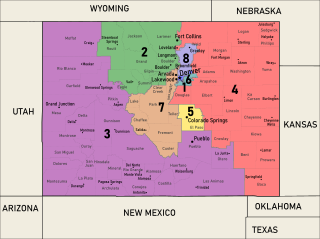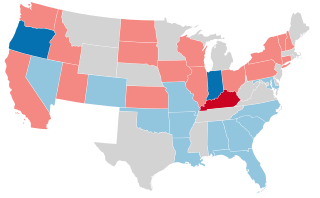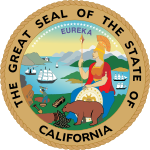
Since Colorado became a U.S. state in 1876, it has sent congressional delegations to the United States Senate and United States House of Representatives, beginning with the 44th United States Congress. Prior to statehood, the Colorado Territory sent non-voting delegates to the House of Representatives from 1861 to 1876. Each state elects two senators to serve for six years, and members of the House to two-year terms. Each state elects two senators to serve for six years in general elections, with their re-election staggered. Prior to the ratification of the Seventeenth Amendment in 1913, senators were elected by the Colorado General Assembly. Each state elects a varying number of, but at least one, member of the House, depending on population, to two-year terms. Colorado has sent eight members to the House in each congressional delegation since the 2020 United States Census.

George Clement Perkins was an American businessman and politician. A member of the Republican Party, Perkins served as the 14th Governor of California from 1880 to 1883, and as United States Senator from California from 1893 to 1915. He also served in the California State Senate.

The 1908–09 United States Senate elections were held on various dates in various states. As these U.S. Senate elections were prior to the ratification of the Seventeenth Amendment in 1913, senators were primarily chosen by state legislatures. Senators were elected over a wide range of time throughout 1906 and 1907, and a seat may have been filled months late or remained vacant due to legislative deadlock. However, some states had already begun direct elections during this time. Oregon pioneered direct election and experimented with different measures over several years until it succeeded in 1907. Soon after, Nebraska followed suit and laid the foundation for other states to adopt measures reflecting the people's will. By 1912, as many as 29 states elected senators either as nominees of their party's primary or in conjunction with a general election.
California's 1st congressional district is a U.S. congressional district in California. Doug LaMalfa, a Republican, has represented the district since January 2013. Currently, it encompasses the northeastern part of the state. Since the 2022 election, it includes the counties of Butte, Colusa, Glenn, Lassen, Modoc, Shasta, Siskiyou, Sutter, and Tehama, and most of Yuba County. The largest cities in the district are Chico, Redding, and Yuba City.

The 1894–95 United States Senate elections were held on various dates in various states. As these U.S. Senate elections were prior to the ratification of the Seventeenth Amendment in 1913, senators were chosen by state legislatures. Senators were elected over a wide range of time throughout 1894 and 1895, and a seat may have been filled months late or remained vacant due to legislative deadlock. In these elections, terms were up for the senators in Class 2.

The 1896–97 United States Senate elections were held on various dates in various states. As these U.S. Senate elections were prior to the ratification of the Seventeenth Amendment in 1913, senators were chosen by state legislatures. Senators were elected over a wide range of time throughout 1896 and 1897, and a seat may have been filled months late or remained vacant due to legislative deadlock. In these elections, terms were up for the senators in Class 3.

The 1872–73 United States Senate elections were held on various dates in various states, coinciding with President Ulysses S. Grant's re-election. As these U.S. Senate elections were prior to the ratification of the Seventeenth Amendment in 1913, senators were chosen by state legislatures. Senators were elected over a wide range of time throughout 1872 and 1873, and a seat may have been filled months late or remained vacant due to legislative deadlock. In these elections, terms were up for the senators in Class 3.

The 1874–75 United States Senate elections were held on various dates in various states. As these U.S. Senate elections were prior to the ratification of the Seventeenth Amendment in 1913, senators were chosen by state legislatures. Senators were elected over a wide range of time throughout 1874 and 1875, and a seat may have been filled months late or remained vacant due to legislative deadlock. In these elections, terms were up for the senators in Class 1.

The 1902–03 United States Senate elections were held on various dates in various states. As these U.S. Senate elections were prior to the ratification of the Seventeenth Amendment in 1913, senators were chosen by state legislatures. Senators were elected over a wide range of time throughout 1902 and 1903, and a seat may have been filled months late or remained vacant due to legislative deadlock. In these elections, terms were up for the senators in Class 3.

The 1890–91 United States Senate elections were held on various dates in various states. As these U.S. Senate elections were prior to the ratification of the Seventeenth Amendment in 1913, senators were chosen by state legislatures. Senators were elected over a wide range of time throughout 1890 and 1891, and a seat may have been filled months late or remained vacant due to legislative deadlock. In these elections, terms were up for the senators in Class 3.

The 2014 United States Senate election in Louisiana was held on November 4, 2014, to elect a member of the United States Senate to represent the State of Louisiana.
The 1895 United States Senate election in Massachusetts was held in January 1895. Incumbent Republican Senator George Frisbie Hoar was re-elected to a fourth term in office.

The 1893 United States Senate election in California was held on January 19, 1893, by the California State Legislature to elect a U.S. Senator to represent the State of California in the United States Senate. In a special joint session, former Democratic Lieutenant Governor Stephen M. White was elected over former Republican Governor George C. Perkins, incumbent Republican Senator Charles N. Felton, and several other candidates.

The 1897 United States Senate election in California was held on January 12, 1897, by the California State Legislature to elect a U.S. Senator to represent the State of California in the United States Senate. Incumbent Republican Senator George Clement Perkins was re-elected to a second term in office, defeating several Democratic and Populist challengers.

The 1909 United States Senate election in California was held on January 12, 1909, by the California State Legislature to elect a U.S. Senator to represent the State of California in the United States Senate. Incumbent Republican Senator George Clement Perkins was re-elected to a fourth term in office with no serious opposition.

The 2024 United States Senate elections are scheduled to be held on November 5, 2024, as part of the 2024 United States elections. Thirty-three out of the 100 seats in the U.S. Senate will be contested in regular elections. Senators are divided into three classes whose 6-year terms are staggered so that a different class is elected every two years. Class 1 senators will face election in 2024.

The 2026 United States Senate elections are scheduled to be held on November 3, 2026, with 33 of the 100 seats in the Senate being contested in regular elections, the winners of which will serve 6-year terms in the United States Congress from January 3, 2027, to January 3, 2033. Senators are divided into 3 groups, or classes, whose terms are staggered so that a different class is elected every 2 years. Class 2 senators were last elected in 2020, and will be up for election in 2032.



















